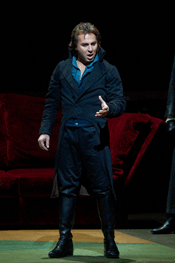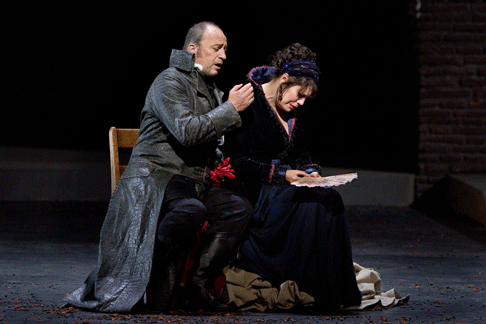The firing squad doesn’t rehearse during the exquisite music
Puccini wrote to illustrate a perfectly silent, motionless dawn in Rome;
instead, the Jailer plays chess with Cavaradossi. The show is still hideously
ugly, no incitement to any opera-lovers ever to return to this opera, but
casting three terrific singing actors in the leads—one of them a role
debut, another a surprise, last-minute house debut, no less—makes a world
of difference to the Tosca experience (as perhaps the presentation
should be entitled). Seeing any director monkey with a theatrical machine as
carefully made as Tosca, with its precise alignments of movement to
music (the window that must be shut just as the cantata cuts off, the candles
placed beside the corpse, the sunrise with churchbells, and dozens more),
you’d think, would give opera directors pause about attempting to
“improve” on a classic. But it doesn’t. They just think how
much of a reputation they can make by breaking the smoothly running parts. Why
don’t they just piss on it out of our sight? That would contribute as
much.
 Roberto Alagna as Cavaradossi
Roberto Alagna as Cavaradossi
However: Considering the train wreck of a year ago—was it
only?—my return to Tosca proved surprisingly satisfying.
Sondra Radvanovsky was singing her first Tosca at the Met—was it her
first anywhere? She has a big voice—Met-sized, I’d call it. Too,
she is a handsome woman and a passionate actress, with excellent stage
instincts. She has been known to go overboard at times, and she did so here, in
the outsize boohoos that ornamented her response to her lover’s apparent
treachery in Act I, and in the “roll in the hay” under Cavaradossi
on the church floor, but opera, especially Verismo opera, is an art with room
for going overboard that is not often utilized these days, or not by singers,
or not by singers with any gift for high style. I found her thrilling in the
part.
My doubts about Radvanovsky have to do with a basic harshness of her
instrument. The color does not always give pleasure in sensuous roles with a
touch of bel canto to them, such as Leonora (her signature part) or Elena. But
Tosca does not fall into that category: Even at her most sensuous, this woman
is brittle, excited, suspicious, a little frantic. Radvanovsky inhabited Tosca
as Tosca has not been inhabited in the Met for some time. Just don’t
expect any Tebaldi or CaballÈ legatos.
 Falk Struckmann as Scarpia and Sondra Radvanovsky as Tosca
Falk Struckmann as Scarpia and Sondra Radvanovsky as Tosca
Marcelo ¡lvarez was to have sung Cavaradossi. He withdrew mere hours before
the performance, and Roberto Alagna, who was in town to sing Don JosÈ and has
never sung Cavaradossi here, stepped in for him. What a treat! It says a great
deal for Mr. Alagna’s stage sense, which has never been in doubt, that he
rarely seemed confused by this unpredictable and complicated staging. His
singing, a bit tentative and low-powered at first, built in the course of the
evening to the appropriate fire and polish for “Vittoria,
vittoria!” His “E lucevan le stelle” was not the most
sensuous or dreamy account one has heard of it, but it was gritty and real,
poignant and despairing. There was genuine chemistry between him and his
Floria, and genuine shock on her part when she found he was dead.
Falk Struckmann is more actor than voice, and Scarpia rewards such talent.
He did not overdo the gross touches director Luc Bondy inserted into this
staging, and his authority and brutality were in no doubt, but he used them
suavely, not overbearingly: a commanding figure, not a gross one. This led to
one moment of great humor: When Tosca informed him she intended to leave Rome
(after yielding to his lust), Struckmann’s Scarpia parodied a tearful
admirer, sentimentally brokenhearted by the news—sarcastically amused by
her melodramatic reaction. Too, he was laughing when he assaulted her at last,
so that we could enjoy his furious discomfiture the more.
Two further things added to my enjoyment: On this the first night in the
production (and with no rehearsal for one of the leading singers), no one
seemed to be staring at the conductor, Marco Armiliato, who pieced the
well-molded parts of the Tosca jigsaw puzzle together with admirable
skill and precision, drowning no one out, foreshadowing and echoing with
precision. Second, they have figured out how to mime Tosca’s leap into
space without forfeiting either probability or the desired shock.
John Yohalem
image=http://www.operatoday.com/Tosca_Met_2010-11_01.gif
image_description=Sondra Radvanovsky as Tosca [Photo by Marty Sohl courtesy of The Metropolitan Opera]
product=yes
product_title=Giacomo Puccini: Tosca
product_by=Tosca: Sondra Radvanovsky; Cavaradossi: Roberto Alagna; Scarpia: Falk Struckmann; Angelotti: Peter Volpe. Conducted by Marco Armiliato. Metropolitan Opera, performance of January 10.
product_id=Above: Sondra Radvanovsky as Tosca
All photos by Marty Sohl courtesy of The Metropolitan Opera